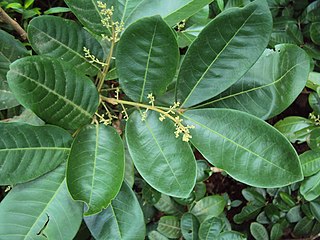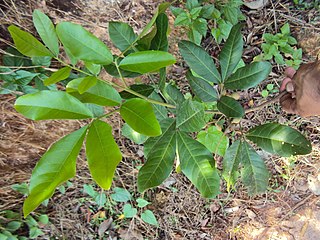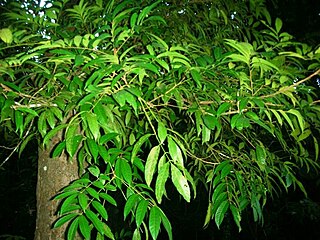
Aglaea or Aglaïa is the name of several figures in Greek mythology, the best known of which is one of the three Charites or Gratiae (Graces).

Aglaia is a genus of 117 species of woody dioecious trees belonging to the Mahogany family (Meliaceae). These trees occur in the subtropical and tropical forests of Southeast Asia, Northern Australia and the Pacific.

Traditionally, Vietnamese tea drinking is considered a hobby of the older, more learned members in households and in society in general, although currently it has been becoming more popular in younger demographics as well. Tea drinking would accompany aristocratic activities such as composing poems, tending flowers, or simply appreciating nature. Vietnamese people generally favor lighter teas with flower fragrance, such as green tea or floral-scented white tea.
Aglaia apiocarpa is a species of plant in the family Meliaceae. It is found in Southern India and Sri Lanka.

Aglaia argentea is commonly known as Silver Boodyara, Bekak, or Koping-koping. [5] It is a tropical wild grown evergreen native to Australia, throughout East Asia and in several Pacific islands.[6]
Aglaia basiphylla is a species of plants in the family Meliaceae. It is endemic to Fiji.
Aglaia cinnamomea is a species of plant in the family Meliaceae. It is found in Papua, Indonesia and Papua New Guinea. Although it was treated as a separate species in a 1998 assessment by the IUCN Red List, other sources include it within Aglaia elliptica.

Aglaia edulis is a tree species of plant in the family Meliaceae. It occurs in Tropical Asia from India to Yunnan and South-Central China. The wood and timber are used for various purposes.

Aglaia elaeagnoidea, the droopy leaf or priyangu, is a species of plant in the family Meliaceae. It is a 10m tall tree found in American Samoa, Australia, Cambodia, India, Indonesia, Malaysia, New Caledonia, Papua New Guinea, the Philippines, Samoa, Sri Lanka, Taiwan, Thailand, Vanuatu, and Vietnam.

Aglaia lawii is a species of tree in the family Meliaceae. As well as the autonym species, there are two subspecies accepted.
Aglaia leptantha is a species of tree in the family Meliaceae. It is found in Mainland and Island Southeast Asia. People use the plant for food, incense, and for human and bovine medicine. Gibbons also eat parts of the tree.

Aglaia odorata is a species of plant in the family Meliaceae. It is found in Cambodia, China, Indonesia, Myanmar, Taiwan, Thailand, Vietnam, and possibly Laos.

Aglaia rimosa is a species of plant in the family Meliaceae. It is found in Indonesia, Papua New Guinea, the Philippines, and Taiwan.

Aglaia spectabilis is a species of tree in the family Meliaceae, found from the Santa Cruz Islands in the southwest Pacific to Queensland (Australia), Southeast Asia, Yunnan (Zhōngguó/China) and the Indian subcontinent. It grows from a 1m shrub to an emergent 40m tall tree, depending on the habitat. Its wood is commercially exploited as timber, but otherwise is of poor quality with limited use. The fruit are eaten, and used in folk medicine. The seeds are large in comparison to other plants, and a major source of dispersal of the species are hornbills eating the fruit, flying away from the tree and regurgitating the seeds.
Aglaia beccarii is a tree in the family Meliaceae. It grows up to 25 metres (80 ft) tall with a trunk diameter of up to 30 centimetres (12 in). The bark is greyish brown, greenish brown or white. The fruits are pink or reddish purple. The tree is named for the Italian botanist Odoardo Beccari. Habitat is forests from sea-level to 1,500 metres (5,000 ft) altitude. A. beccarii is found in Borneo and the Philippines.
Aglaia bullata is a tree in the family Meliaceae. It grows up to 10 metres (30 ft) tall with a trunk diameter of up to 12 centimetres (5 in). The bark is greyish brown. The fruits are roundish, brownish yellow, up to 1.5 cm (1 in) in diameter. The specific epithet bullata is from the Latin meaning "puckered", referring to the leaflets. Habitat is mixed dipterocarp forests from sea-level to 420 metres (1,000 ft) altitude. A. bullata is endemic to Borneo and confined to Malaysia's Sarawak state.
Aglaia rufibarbis is a small tree in the family Meliaceae. It grows up to 5 metres (20 ft) tall with a trunk diameter of up to 5 centimetres (2 in). The bark is usually grey and pale brown, sometimes dark brown. The fruits are roundish, up to 2 cm (1 in) in diameter. The specific epithet rufibarbis is from the Latin meaning "red beard", referring to the reddish brown hairs of the indumentum. Habitat is mixed dipterocarp forests from 100 metres (300 ft) to 250 metres (800 ft) altitude. A. rufibarbis is found in Peninsular Malaysia and Borneo.
Aglaia sessilifolia is a tree in the family Meliaceae. It grows up to 12 metres (40 ft) tall with a trunk diameter of up to 20 centimetres (8 in). The bark is greyish brown or dark brown. The flowers are yellow. The fruits are ellipsoid, up to 2.5 cm (1 in) long. The specific epithet sessilifolia is from the Latin meaning "stalkless leaf". Habitat is limestone hill forests from sea level to 1,000 metres (3,300 ft) altitude. A. sessilifolia is endemic to Borneo and confined to Malaysia's Sabah state.
Aglaia soepadmoi is a tree in the family Meliaceae. It grows up to 7 metres (20 ft) tall. The fruits are roundish, up to 2 cm (1 in) in diameter. The tree is named for botanist and editor of Tree Flora of Sabah and Sarawak Engkik Soepadmo. Habitat is forests from sea-level to 1,100 metres (3,600 ft) altitude. A. soepadmoi is found in Sumatra and Borneo.
Aglaia stellatopilosa is a tree in the family Meliaceae. It grows up to 8 metres (30 ft) tall with a trunk diameter of up to 10 centimetres (4 in). The bark is greyish green. The fruits are roundish; yellow, orange or yellowish brown when ripe; up to 2.3 cm (1 in) in diameter. The specific epithet stellatopilosa is from the Latin meaning "stellate hairs", referring to those on the twigs. Habitat is forests from sea-level to 1,200 metres (4,000 ft) altitude. A. stellatopilosa is endemic to Borneo.










